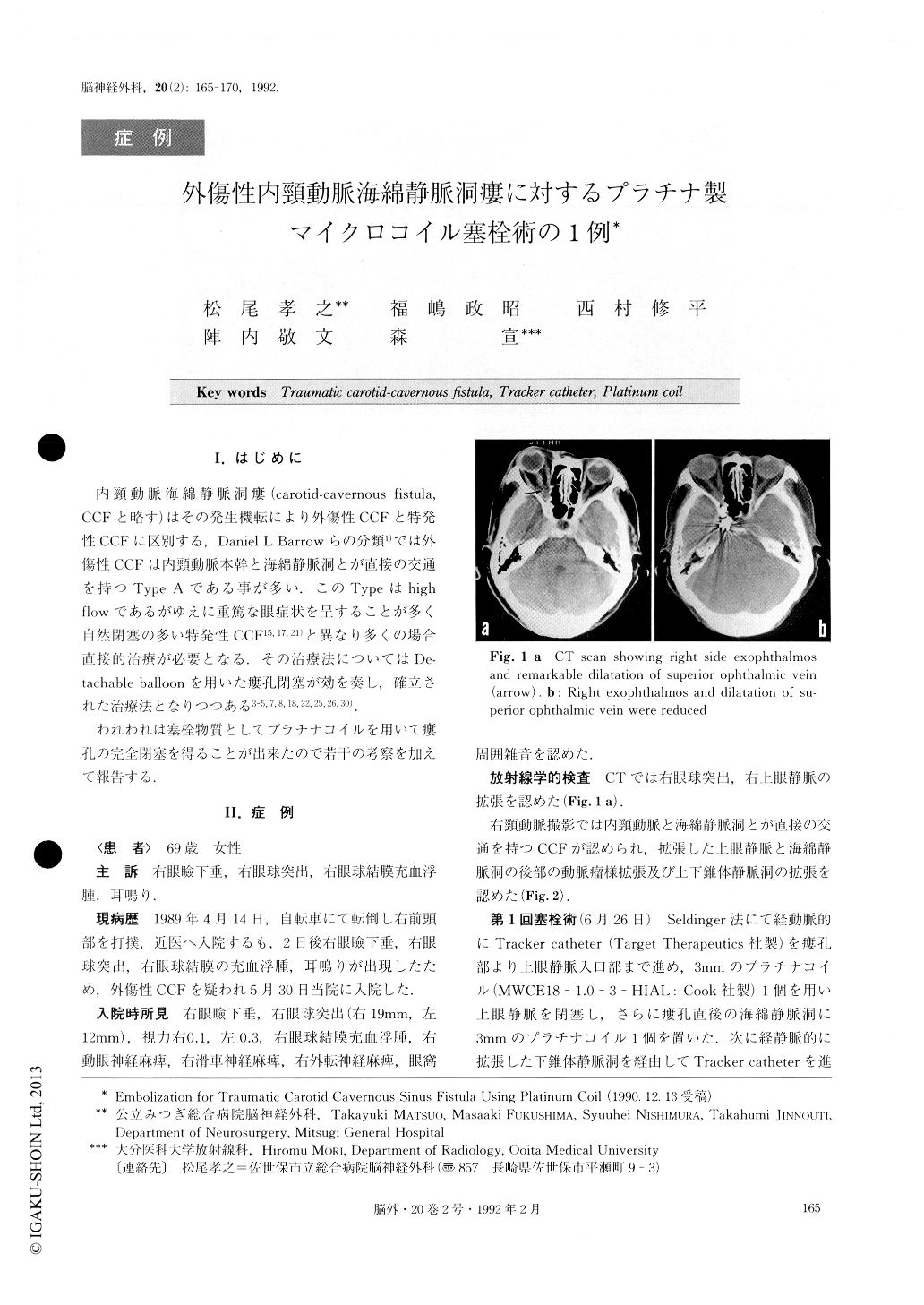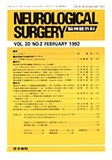Japanese
English
- 有料閲覧
- Abstract 文献概要
- 1ページ目 Look Inside
I.はじめに
内頸動脈海綿静脈洞瘻(carotid-cavernous fistula,CCFと略す)はその発生機転により外傷性CCFと特発性CCFに区別する,Daniei L Barrowらの分類1)では外傷性CCFは内頸動脈本幹と海綿静脈洞とが直接の交通を持つType Aである事が多い.このTypeはhighflowであるがゆえに重篤な眼症状を呈することが多く自然閉塞の多い特発性CCF15,17,21)と異なり多くの場合直接的治療が必要となる.その治療法についてはDe—tachable balloonを用いた瘻孔閉塞が効を奏し,確立された治療法となりつつある3-5,7,8,18,22,25,26,30).
われわれは塞栓物質としてプラチナコイルを用いて瘻孔の完全閉塞を得ることが出来たので若干の考察を加えて報告する.
We treated a patient with a traumatic carotid-cavernous fistula (CCF) by embolization using a Track-er catheter and platinum coils by transarterial and transvenous approaches.
A 65-year-old female sustained an injury in the right frontal region of the head in April, 1989. After 1 month, she was admitted to our hospital due to ex-ophthalmos, congestion of the palpebral conjunctiva, ptosis, and a bruise in the right frontal region of the head. Right carotid angiography showed a CCF be-tween the anterior ascending segment and the horizon-tal segment that drains into the superior. ophthalmic vein, superior petrosal sinus and inferior petrosal sinus. To occlude the fistula, embolization was performed twice using platinum coils. In the first embolization, the cavernous sinus was approached transarterially and tansvenously using a Tracker catheter system, and atotal of 7 platinum coils were used for the embolization. The bruise disappeared immediately after embolization but recurred 3 clays after the operation. Angiography demonstrated re-communication of the CCF. The second embolization was initially performed using a de-tachable balloon, but the balloon could not be passed through the fistula. Therefore, a Tracker catheter was advanced to the fistula transarterially and embolization was performed using 3 platinum coils. The fistula was occluded.
Follow-up angiography after 1 year in August, 1990 showed complete occlusion of the fistula. The detachable balloon system was recently intro-duced in neurological and radiological departments, as a new surgical method for CCF. At present, this method is the first choice for CCF. However, the detachable balloon system presents some technical problems. In direct CCF, the balloon can be placed in the cavernous sinus transvenously through the fistula and occludes the fistula while blood flow in the carotid artery is pre-served. However, when the diameter of the fistula is smaller than the diameter of the balloon before infla-tion, preservation of the carotid artery is difficult. On the other hand, fistulas with a small diameter can beapproached transarterially using the Tracker catheter system because of its flexibility. The transarterial approach is impossible when obstruction is present on the central side of the carotid artery. The tortuosity of the artery makes manipulation of the catheter difficult. In such cases, the transvenous approach is effective. The balloon is difficult to place by the transvenous approach at the site of the cavernous sinus near the fis-tula due to the interference of the trabeculae in the cavernous sinus. The Tracker catheter system allows accurate placement of the balloon in the thrombotic substance of the fistula.
The combined use of the Tracker catheter and plati-num coils cannot utilize blood flow for approaching the fistula but requires no specific techniques such as bal-loon inflation and detachment such as are needed with the detachable balloon system. The advantages of plati-num coils are availability, radiopacity, thrombogenicity, biocompatibility, and utilization for the Tracker cathe-ter system. The usefulness of embolization using the Tracker catheter system and platinum coils for trauma-tic CCF may be more firmly established in the future.

Copyright © 1992, Igaku-Shoin Ltd. All rights reserved.


